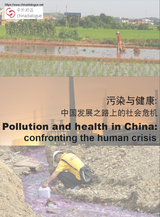Just over a year ago, in July 2013, a report published in the U.S. journal Proceedings of the National Academy of Sciences, put the health impacts of air pollution in China into an unusually clear framework: residents of south China, the report said, could expect to live five years longer than their 500 million compatriots who live north of the Huai River. For the authors, researchers at Peking University, Tsinghua University, and the Hebrew University of Jerusalem, the reason was simple: north of the river, the legacy of previous government subsidies is the predominance of coal fired heating systems that see people through the harsh northern winters.
Reports
09.07.14
Pollution and Health in China: Confronting the Human Crisis
The less benign result, however, is a level of air pollution produced by burning coal, measured by particulate matter, that is about 55% greater than in south China and that literally takes years off northern lives.
There are other grim facts associated with air pollution: if we look at healthy years of life (as opposed simply to years of life) it is clear that the gains in longevity and well-being that China has made in the last 100 years are being eroded.
Anyone who lives in north China understands that the air quality that they endure is potentially hazardous. There are other environmental hazards to health that have been less obvious or less widely understood, but that emerge in patterns of illness among populations in certain areas: the cancer villages that can be identified, particularly around chemical industry installations, for example, or elevated levels of lead that are found in children in certain areas, as a result of battery production or simply proximity to coal-fired power generation.
Lead poisoning can cause damage to the liver and kidneys, as well as permanent intellectual and development disabilities, and children up to the age of seven are particularly vulnerable because of their immature central nervous systems.
China’s health statistics reveal that the country ranks second in the world for lung disease and 12th for lung cancer. Chinese people also suffer from the world’s third highest rates of stomach cancer and the third highest rates of liver cancer, ill health that is highly likely to have environmental causes.
Then there are the impacts on food safety of widespread pollution, in particular the use of contaminated water for irrigation. As He Guangwei reports for chinadialogue, cadmium contamination in rice grown in Hunan province, China’s most important rice producing province, has proved to be a persistent and difficult issue to deal with because of the proximity of poorly regulated mining and chemical industries to agricultural areas.
Other contaminated foodstuffs that have alarmed consumers in recent years include fish, meat, and milk, leaving Chinese citizens profoundly anxious about the safety of the food they eat and feed to their families.
These problems have been accumulating for at least three decades, and they are the counterpoint to the story of China’s remarkable economic growth. The argument is often made that developing countries cannot afford to insist on environmental standards, and such standards can seem expensive in a country that is trying to grow out of poverty. But the failure to design and enforce good environmental protection standards also carries huge costs—costs that are paid by the public purse and in the lives and families of ordinary people.
The price of environmental degradation and pollution is expressed in human suffering, in impaired development, in remediation costs, in lost days, and in lower quality of life. Addressing these ills is neither easy nor straightforward, as Jennifer Holdaway and Wang Wuyi explain in their article. Environmental health, they point out, “is a notoriously challenging policy area in any country because pollution-related health impacts have complex causality and require a multifaceted governance response. They also often provoke conflicts of interest and contestation over responsibility not just between communities and polluting industries but also between whole jurisdictions and regions.”




